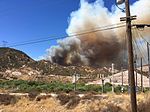Meyer Canyon Creek
California river stubsRivers of San Bernardino County, CaliforniaRivers of Southern CaliforniaSan Bernardino County, California geography stubs
Meyer Canyon Creek is a tributary of Lytle Creek in San Bernardino County, California.
Excerpt from the Wikipedia article Meyer Canyon Creek (License: CC BY-SA 3.0, Authors).Meyer Canyon Creek
Meyers Canyon Road,
Geographical coordinates (GPS) Address Nearby Places Show on map
Geographical coordinates (GPS)
| Latitude | Longitude |
|---|---|
| N 34.203611111111 ° | E -117.44472222222 ° |
Address
Meyers Canyon Road
Meyers Canyon Road
California, United States
Open on Google Maps



